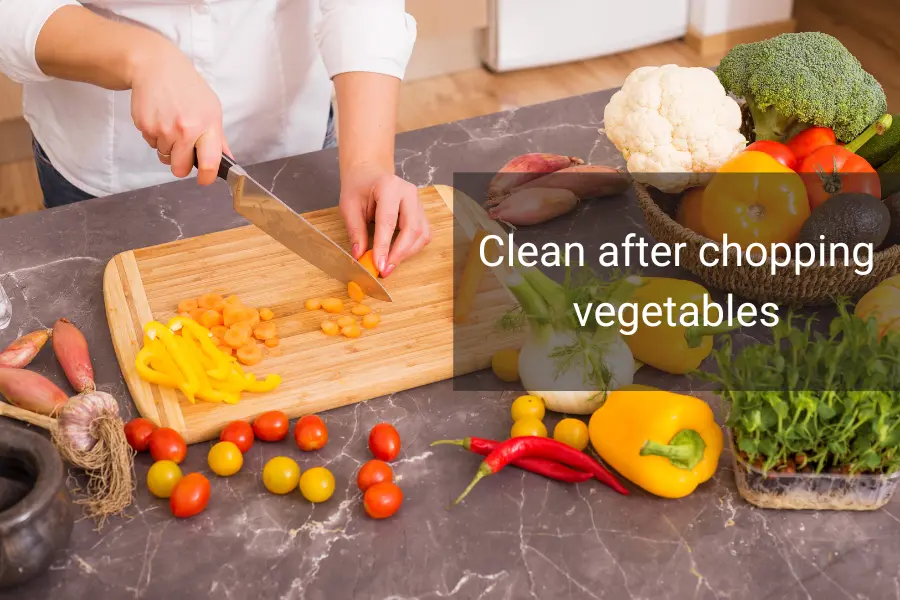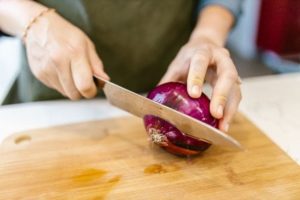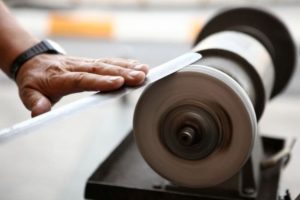Many of us take importance of cleanliness for granted when it comes to our kitchen knives.
Our kitchen knife is one of the most commonly used tools when it comes to preparing food, but it can also be a potential source of cross-contamination and food-borne illness if not properly disinfected.
In this blog post, we’ll explore when must a knife be cleaned and sanitized. Also the best practices for cleaning and sanitizing your knives, so you can rest easy knowing your kitchen is safe and healthy.
- Importance of cleaning and sanitizing knives
- When should a knife be cleaned?
- Proper methods of cleaning and sanitizing knives
- When must a knife be cleaned and sanitized?
- How to clean a knife?
- How to sanitize your knife?
- Hand wash or Dishwasher: What to Choose
- What is the difference between cleaning and sanitization?
- How to store your knives?
- FAQs': When a knife should be cleaned and sanitized
- Conclusion: When must a knife be cleaned and sanitized?
Importance of cleaning and sanitizing knives
A dirty knife can contaminate food with harmful bacteria such as Salmonella, E. Coli, and Listeria, which can cause food poisoning, stomach cramps, and diarrhea.
Furthermore, the bacteria can easily spread to other kitchen utensils, surfaces, and food items, making the problem worse.
Therefore, it’s crucial to clean and sanitize knives regularly to prevent the spread of bacteria and keep the kitchen environment safe and healthy. If you take good care of your knife, it will serve you for a long time.

When should a knife be cleaned?
When must a knife be cleaned and sanitized? Food safety!
Cleaning knives should be done after each use, as food particles and bacteria can accumulate on the blade and handle. This is especially important when switching between different types of food or when handling raw meat or poultry.
If you have dropped the knife on the floor or contaminated with foreign substances, it should be cleaned immediately.
Lastly, knives should be cleaned and sanitized before and after food preparation, as well as when switching between different food items.
It will prevent contamination and ensure food safety!
Proper methods of cleaning and sanitizing knives
While many people rinse their knives, it’s not a surefire way to keep the blades clean and hygienic.
However, the process to get a clean slide free of harmful pathogens and microorganisms is simple. Also, the air is not entirely safe and is riddled with pollutants which provide an ideal breeding ground for bacteria.
To effectively clean and sanitize knives, it’s essential to follow the proper methods to ensure that all harmful bacteria and food residues are removed.
The following are some of the recommended methods:
Hand washing with soap and water
Hand washing is the most common and effective way of cleaning knives. The knife should be washed with warm soapy water, using a clean sponge or cloth to remove any food residues and dirt. Then, the knife should be rinsed thoroughly with clean water and dried with a clean towel.
Using a dishwasher
If the knife is dishwasher safe, it can be cleaned in the dishwasher using a high-temperature cycle and detergent. However, some knives may not be dishwasher safe, so it’s essential to check the manufacturer’s instructions before using this method.
Sanitizing with a solution
After cleaning the knife, it should be sanitized using a solution of one tablespoon of bleach to one gallon of water. The knife should be soaked in the solution for at least one minute and then rinsed thoroughly with clean water and dried with a clean towel.

When must a knife be cleaned and sanitized?
There is no definitive answer as it varies from person to person depending on various factors such as type of blade and culinary task. With that being said, let’s look at a few cases that require blade cleaning and sanitizing.
After slicing raw meat
It is obvious that raw meat can transmit germs and bacteria if you do not clean the blades properly.
Once you have sliced raw meat on your cutting board, we recommend cleaning the board and knife immediately to prevent the spread of bacteria and germs that will likely lead to food contamination.
Regardless of the type of blade you use, it is a good idea to clean and sanitize it with bleach and hydrogen peroxide.
After cutting different types of food
Most people use a single knife and cutting board to cut a huge assortment of foods without proper cleaning and sanitizing, leading to cross-contamination.
After slicing raw meat, wash the blade thoroughly before cutting vegetables and fruits.
It’s best to have a few different cutting boards for different types of food.
If you use the same knife to chop different foods, it leads to contamination and adverse health effects. This can be avoided by properly cleaning and disinfecting the blade and handle.
After scaling the fish
Once you are done filleting or cleaning the fish, it is essential to thoroughly clean the blade of your knife before using it to cut fruits or vegetables to avoid cross contamination. Keeping a knife clean is also important for maintenance.
When sharing knives
Bacteria are not confined to the vicinity of the knife’s blade; the bacteria can also hide in the handle of the knife. Washing the knife handle thoroughly will greatly reduce the risk of contamination. When preparing food at home, family members can share the same knife without risk. So long as everyone has clean hands, the knife will remain clean.
If you are a professional cook, there is a greater risk of contamination from spreading knives in a kitchen or restaurant. You may come into contact with other contaminated surfaces, such as countertops or sinks, when cutting or dicing. If they get a knife and begin to slice with it, they could contaminate food that they make and their coworkers’ hands. Before long, many people will be contaminating food everywhere.
This highlights why washing hands is so important in cooking. It’s also important to wash knife handles after others have used them.
After cutting yourself
If you have a cut while using a kitchen knife, you should seek first aid or medical attention. Clean your kitchen knife and any other surfaces with your blood before applying bandages. Anyone drinking blood can contract viral diseases like hepatitis and HIV.
When cutting up containers of blood, sterile the utensils afterward as an additional precaution.
After sharpening
Sharpening a knife hones the blade’s angle by pulverizing minor particles. Clearly, you do not want to eat tiny particles of food. If you forget to clean a knife after sharpening it, you may inadvertently transfer metal fragments to your ingredients.
One problem is that the metal can spoil the flavor of your meal. A much more serious problem is that heavy metal poisoning can lead to severe health complications. Thus, raw chicken is not the only cause for concern. Be sure to thoroughly wash and scrape the knife blade after sharpening.

How to clean a knife?
- Start by removing any food debris from the knife blade. This may include fat, cheese, or breadcrumbs. Simply wipe the blade with a paper towel to get rid of any debris.
- Once the blade is clean, prepare some hot water. You can use water from your tap or kettle. Boiling water is the most effective method for killing bacteria.
- Rinse the knife with hot water. You can pour the hot water over the blade or submerge the knife in a tray of boiling water. However, if you submerge the knife, don’t leave it in the water for too long.
- Use a clean sponge and dish soap to scrub the blade and handle of the knife. Be sure to avoid touching the blade or point with your fingers.
- Wash off the soap with warm water.
- Finally, dry the clean knife using a tissue or paper towel.
How to sanitize your knife?
- Prior to sanitizing, make sure to clean the knife using the instructions provided above.
- Fill a bowl with approximately 1 liter of water and add roughly a teaspoon of bleach.
- Submerge the knife into the bowl of water and let it sit for about 1 minute.
- Remove the knife from the bowl and dry it with a paper towel.
Hand wash or Dishwasher: What to Choose
One of the most important things you can do is to regularly wash your kitchen tools properly. This includes knives, which should never be put in the dishwasher.
Using a dishwasher to clean your knives can damage their quality. The harsh detergents used can cause corrosion, and the aggressive wash cycle can bang the delicate tools around, resulting in a dull blade over time. Moreover, the knives may also scratch the plastic coating of the dishwasher.
To wash your knife properly, the best approach is to soak it in a bleach solution and use hand soap. This will ensure that all the germs are effectively eliminated. Running the knife under tap water alone may not be enough to fully clean it.
If you properly clean and sanitize your knives, you can help ensure that your kitchen remains a safe and healthy environment for food preparation.

What is the difference between cleaning and sanitization?
Cleaning and sanitization both aim to make something safe to use by removing harmful bacteria. However, while basic cleaning is a necessary process for all kitchen utensils and should happen after every use, sanitization is an additional step that can be taken to further neutralize any remaining bacteria on the item.
The main goal of both cleaning and sanitization is the same: to kill any harmful bacteria that may be present on the item in question, such as a knife. However, the difference between the two is not always clear-cut. Some people may consider washing a utensil with boiling water to be a form of sterilization, for example.
In terms of frequency, cleaning is something that should ideally happen after every use, whereas sanitization is not always necessary. Sanitization is usually only required if there is a risk of infection from blood or other hazardous materials on the item.
Overall, both cleaning and sanitization are important processes in maintaining a safe and hygienic kitchen environment, but the extent to which they are necessary will depend on the individual situation.
How to store your knives?
Keeping your knives clean is not only about washing them, but also ensuring they remain clean while in storage. To achieve this, it’s important to store them in a germ-free environment.
There are various knife storage options available, but it’s crucial to choose the ones that are most hygienic and effective, rather than simply going for convenience.
Here are some practical and sanitary ways to store your knives:
If you want to store your knives in a more sanitary way, consider the following options:
- Magnetic knife rack: This modern storage solution is both stylish and practical, as it saves space and makes your knives easily accessible. The magnetic strip is easy to clean, ensuring a germ-free environment for your knives.
- Knife sheath: Individual knife sheaths protect the blades from damage and allow you to store them in a drawer or cupboard. They are easy to clean if they get dirty.
- Knife roll: Chefs who travel with their knives may prefer a knife roll, which can be washed periodically to maintain optimal hygiene.
Not much effective method to sanitize your knife, but it still better than nothing:
Knife block: This is a convenient way to keep your knives in one place on your kitchen counter. However, the slots can be challenging to clean, and over time, dirt and debris can accumulate inside the block, contaminating your knife blades. Therefore, it may not be the most hygienic option.
Knife drawer tray: A knife tray is a compact and safe way to store your knives in a drawer. While it’s not as difficult to clean as a knife block, the narrow slots can still collect dust and dirt, which can affect the cleanliness of your knives. Consider using a tray with wider slots to make cleaning easier and to maintain optimal hygiene.
FAQs’: When a knife should be cleaned and sanitized
Let’s explore the answers to some of the most frequently asked questions about cleaning and sanitizing knives.
1. Should you clean your knives with alcohol?
It depends on the type of knife. Alcohol can be the holy grail for getting rid of dangerous pathogens and microorganisms.
However, it is not recommended for high quality knives. Most kitchen knives are made from low-carbon stainless steel, which makes them susceptible to long-term damage or corrosion from alcohol, especially around the edges. However, if you want to use alcohol to remove rust from your knives, this is a surefire way to go about it.
2. Should you wipe or clean your knife after sharpening or sharpening it?
Yes! Once you have sharpened the blade you need to clean it as this involves grinding the steel leaving particles on the surface. Cleaning removes microscopic particles on the blade.
3. Does water dull knives?
Water cannot dull the blades unless they are soaked in water for days or hours. Also, it is advisable to use lukewarm water rather than hot water to rinse your knives after cleaning.
4. What is the best way to maintain your kitchen knives?
As stated earlier, one of the best ways to keep your knives clean is to use soapy water and hydrogen peroxide.
5. Is soapy water enough to clean and sanitize your knives?
Soapy water is enough to clean your knives, but not enough to disinfect them. To sanitize the blades (i.e. kill harmful bacteria and microorganisms), you should use hydrogen peroxide or bleach. We do not recommend using heat (88°C or 190°F) as this damages the blades in the long run. Also, you should always rinse your knives with warm rather than hot water.
6. How often should you clean your knives?
It depends on how often you use the knives. For example, if you cut meat every few days, you will need to clean and sanitize the blades each time you use it. Also, the frequency of cleaning depends on the type of food you are cutting.
After all, raw meat or fish contain more bacteria and pathogens than fruit and vegetables, so it’s a good idea to clean your knives after each use. If you don’t, you risk cross-contamination.
7. Is cleaning a knife the same as sanitizing it?
Contrary to popular belief that sanitizing or disinfecting is synonymous with cleaning, there is a slight difference. While cleaning removes dirt and crumbs, sanitizing removes germs and pathogens that dish soap and water cannot.
8. Can I use vinegar instead of bleach to sanitize my knives?
No. While vinegar is a natural disinfectant, it may not be effective in killing all types of harmful bacteria. Therefore, it’s recommended to use bleach to sanitize knives.
9. How often should I sanitize my knives?
Knives should be sanitized after cleaning, especially when handling different types of food or when contaminated with foreign substances.
10. Can I clean my knives in the dishwasher with other utensils?
You should clean knives separately from other utensils to prevent damage to the blade or handle.
Conclusion: When must a knife be cleaned and sanitized?
There is no definitive answer to the question “When should a knife be cleaned and sanitized?” This is because it boils down to the factors mentioned in this guide which vary from person to person. Pay special attention to your knives and kitchen utensils and clean them when necessary.
Now that you know how to clean and sanitize your knives, you can do it easily when needed.



